Whether Singapore is your final destination or you have an airport stopover, the city is amazing and has so much to offer! The city is clean, orderly, safe, and easy to digest. Read on to learn the top 10 must-do experiences in the Lion City! Check out my blog post from our first time in Singapore here.
Singapore is an island nation of 275 square miles (728 square km). It is also considered a city-state, as the entire main island is the city. Singapore prides itself on being at the forefront of modern technology, and being a global frontrunner in environmentalism and conservation. Known as “the city in a garden,” there is extensive horizontal and vertical landscaping, making the city feel very green and lush. In addition to being such a green city, there are numerous sites you can visit which have extensive gardens and allow you to feel immersed in nature.
Singapore is a very safe, clean, vibrant city with excellent infrastructure and one of the best public transportation systems in the entire world. The MRT (Mass Rapid Transit system) is easy to understand and navigate, punctual, clean, and safe. Singapore has a very low crime rate, as punishment is swift and harsh. The city is a melting pot of Asian cultures, with heavy Chinese, Malay, and Indian influence, which means… amazing food!
Official languages include English, Mandarin, Malay, and Tamil. You’ll hear them all, but most people have at least basic English. The currency is the Singapore Dollar (SGD). At the time of writing, 1 USD=about 1.3 SGD. So for $5 (USD), you get about $3.75 (SGD). Something that costs $100 SGD would be about $75 USD.
#1: Hawker Centers
Singapore is all about food! One defining thing about Singapore is the Hawker Center. While these can be found in other places like Hong Kong and Malaysia, they originated here, are very common and prominent here, and are recognized by UNESCO as part of their Intangible Cultural Heritage of Humanity.
Singapore was established in the early 1800s and soon transformed into a bustling port city. Entrepreneurial immigrants set up a sort of a floating river market, sharing their unique cuisines with traders and residents. Food stalls spread to the streets, and were the main source of meals for busy people. Soon, conditions became unsanitary and crowded, prompting the government to impose harsh regulations.
Eventually, Hawker Centers were established, providing cleaner, safer conditions for vendors and safer food for patrons. Not only did these original food courts provide higher quality food and better conditions, but community dining areas flourished and provided social centers for the community. Singapore has some of the best food in the world, largely due to its multicultural influence. Cuisine bursts with flavors of Chinese, Indian, and Malay food, which come together to create traditional and unique dishes to satisfy any palate. Here are some of the most popular Hawker Centers!
Newton
This one was featured in Crazy Rich Asians. Newton Food Center has a decent website if you like to plan your meals in advance or want to see what is available. I like this one because the stalls surround the periphery and the seating is in the middle, so it feels very open and not crowded.
La Pau Sat
La Pau Sat is a bustling hub of activity in the heart of the city. It is very touristy, and the vendors can be aggressive, but you can find really good food here. It is super easy to get to no matter where you are staying! There are at least 4 MRT stations within walking distance:
Maxwell Food Centre
This one feels far less touristy than La Pau Sat, at least to me…It is in a large building downtown near the CBD, and is a popular lunch spot for professionals working there. It can get very crowded during lunch and dinner hours, so get there early and be prepared for a cultural experience! Maxwell is famous for many reasons, one of which is its Hainanese chicken and rice. Tian Tian Hainanese Chicken and Rice is thought to be one of the best.
Albert Centre
On our last visit to Singapore, we stayed at the Andaz Singapore by Hyatt. I had just achieved Globalist status and wanted to stay here to take advantage of my perks. I’d recommend staying in the CBD (Central Business District) if it’s your first time in Singapore, but the Andaz was nice because it was right above a train station. Right down the street was Albert Centre, a hawker centre geared more toward locals, where we had a few yummy snacks.
#2: Chinatown
The stench of durian welcomes you to this unique place- it smells kinda like garbage and has one of those tastes you either love or hate. I hate it! Just the smell conjures up memories of the lingering taste of decaying flesh with a hint of custard, which coats the inside of your mouth for hours! People often describe its taste as rich, custardy, and sweet, with notes of almond, caramel, vanilla, and onion — yes, onion.
It’s super creamy, almost like a thick, buttery pudding, with a mix of savory and sweet tones. It almost sounds good, and some people love it. But to me, it is nauseating, stomach-curdling, and foul. It is also called stinky fruit and has earned this nickname. It is banned in hotels and public transportation all over Asia. The smell comes in waves as you wander around Chinatown, and caused us to speed up a few times to get away from it! Meanwhile, my mother-in-law and father-in-law were running toward it!
Chinatown in Singapore is vast and packed with sites to see and food to eat. From temples to street shopping, casual eats to fine dining, you’ll find it here. Don’t miss the Sri Mariamman Temple, a colorful Hindu temple at 244 South Bridge Road, or the Buddha Tooth Relic Temple, a huge Chinese Temple/museum with a rooftop garden.
Singapore’s Chinatown is a vibrant historic district that blends old-world charm with modern flair. Once home to the city’s early Chinese immigrants, it’s packed with beautifully preserved shophouses, temples, and lively street markets. Walking through its narrow streets, you’ll find everything from traditional Chinese medicine halls and clan associations to trendy cafes and boutique shops, making it a place where heritage and contemporary culture coexist. Be sure to look for the murals and street art demonstrating aspects of Singaporean culture.
Beyond its architecture and shopping, Chinatown is a food lover’s paradise. Hawker centers like Chinatown Complex and Maxwell Food Centre serve up beloved local dishes such as chicken rice, char kway teow, and satay. During Chinese festivals, especially Lunar New Year, the area comes alive with colorful decorations, lantern displays, and bustling night markets, drawing both locals and tourists. It’s a must-visit spot to experience Singapore’s multicultural tapestry and rich Chinese heritage.
Explore more of Chinatown here.
- La Pau Sat
- Part of our Feast at LPS
- Chili Crab in Chinatown
#3: Food Tours
Too short on time or not motivated to dive into these centers of tasty chaos on your own? Book a food tour! I booked this one through Viator.
We had a great time with our local guide, Stephan. I can’t share links, because these little cafes don’t have websites, but you can find them on social media. We started out at Mount Faber Nasi Lemak, where we had curry chicken and rice. Sooo good! Then, we had these yummy Chinese waffles made with sticky rice at a gelato shop called Ri Ri Cha. These are called Nian Gao waffles and they were crispy on the outside and soft, chewy, and sticky inside.
Then, we headed to the Chinatown Complex Hawker Center where we visited Ann Chin at stall 2-112. There we had Kueh pie tee, which is a yummy little snack consisting of a puff pastry cup filled with prawns and shredded veggies like Chinese turnips.
Then, we had an oyster omelette which was a little too fishy for me. It was time to go, so we grabbed some satay and took it with us to our next stop- Huaxia Tea House. Our guide had arranged a nice little tea ceremony in which we tried 5 types of tea, the most interesting of which was called “duck shit oolong.” This was due to its appearance and did not reflect its taste or ingredients!
Food tours can be a great option for an intro to Singapore’s hawker centers, particularly if you are short on time!
#4: Gardens by the Bay
You can’t think of Singapore without picturing the Supertrees! These 18 strange creations are up to 50 meters high and are energy factories! Several of them have photovoltaic cells in their canopies to harness the energy of the sun to power their lights and speakers. Some of the trees are integrated with the humongous greenhouses containing the cloud forest and flower garden and function as air exhaust receptacles.
I recommend visiting during the day and at night- during the day, you can see all the colorful plants and lakes, and at night the grove is a magical wonderland of colorful lights and ethereal music. Gardens by the Bay has Supertree Grove, the Cloud Forest, and the Flower Dome. In Supertree Grove, you can take an elevator to the top of the tallest tree to see the observatory. Here, you can learn about the gardens and take in the stunning views from the observation deck.
Walk from one tree to another along the OCBC Skyway (OCBC, if you care, stands for the Oversea-Chinese Banking Corporation) and get some amazing photos. The Cloud Forest contains one of the largest indoor waterfalls in the world, and it is surrounded by a lush rainforest. Not only can you see colorful flowers, tiny orchids, and carnivorous plants, but amazing wood carvings and sculptures hide in every nook, and photo ops beg for your instagram tags.
Both the Flower Dome and Floral Fantasy have ever-changing themes and exhibits that never cease to amaze. All of this is a doable walk from the Bayfront MRT station… I’d be lying if I said it was a short walk! But it is a beautiful walk, by lakes and gorgeous plants, with a nice view of the Marina Bay Sands. If you happen to be staying at the MBS, you can walk to the gardens from your hotel.
#5: Changi International Airport
Few countries have airports worth routing your trip around. In my opinion, Doha, Qatar’s Hamas International Airport and Singapore’s Changi International Airport are the only two. Changi has a very special place called the Jewel.
The Jewel is a nature-themed entertainment and retail complex attached to Terminal 1 of Changi Airport, at the center of which is a 40 meter high waterfall called the Rain Vortex.
🌿 Why You Should Visit Jewel
-
HSBC Rain Vortex
At the heart of Jewel lies the world’s tallest indoor waterfall, the HSBC Rain Vortex, standing at 40 meters high. This stunning feature recirculates rainwater from the roof, cascading down into a basement-level pool. In the evenings, the waterfall transforms into a mesmerizing light and sound show, creating a captivating spectacle. -
Shiseido Forest Valley
Surrounding the Rain Vortex is the Shiseido Forest Valley, one of Asia’s largest indoor gardens. Spanning five stories, it houses approximately 3,000 trees and 60,000 shrubs from 120 species found in high-altitude tropical forests. Visitors can enjoy scenic walking trails and the calming ambiance of this lush sanctuary. -
Canopy Park
Located on the topmost level, Canopy Park offers a range of attractions for all ages. Highlights include the Discovery Slides, a glass-bottomed bridge with panoramic views, the Hedge Maze, and the Foggy Bowls—a playful area filled with mist-filled spheres. These interactive features provide fun and entertainment for families and visitors alike.
- Extensive Retail and Dining Options
Jewel boasts over 300 retail and dining outlets, featuring a mix of international brands and local favorites. Shoppers can explore a variety of stores, while food enthusiasts can indulge in diverse culinary offerings, including renowned establishments like Shake Shack and local delights. - Rest and Relaxation Amenities
For travelers seeking rest, Jewel offers the YOTELAIR hotel with approximately 130 rooms, available for short stays. Additionally, the Changi Lounge provides a comfortable space to relax before flights. These facilities ensure a pleasant and convenient experience for visitors .
Aside from the Jewel, Changi is packed with amazing airline lounges, premium shopping, and excellent food. Forget about grabbing an overpriced cheeseburger from McDonalds. You can get Hawker-center and street-food inspired dishes, have dinner at a fine dining restaurant, or chill in an airport lounge… we had the best fish curry we’ve ever had at the Singapore Airlines business class SilverKris lounge in terminal 3.
The airport is packed with art installations, gardens, and combos of the two. You can even set up a tour of the airport! There’s a butterfly garden, a crystal garden, and tons of places for kids to play and have adventures. Plan a long layover here!
#6: Night Safari
The Night Safari in Singapore is the world’s first nocturnal wildlife park, offering a unique experience where visitors can observe over 900 animals from around the globe in their naturalistic nighttime habitats. Opened in 1994, it’s located next to the Singapore Zoo and spans 35 hectares of lush rainforest. The park features guided tram rides, walking trails, and entertaining shows like the Creatures of the Night performance. Unlike traditional zoos, the Night Safari uses subtle lighting to simulate moonlight, allowing animals to be active and visible without disturbing their natural behaviors — making it one of Singapore’s most popular and immersive eco-tourism attractions.
#7: Singapore Flyer
For a few years now, giant ferris wheels in cities have been a trend. The London Eye, the High Flyer in Las Vegas, The Dubai Eye… If you’re into seeing the city from above, this can be a fun little diversion. The Singapore Flyer is one of the world’s tallest observation wheels, standing at 165 meters high — about the height of a 42-story building! Opened in 2008, it’s located in the Marina Bay area and offers breathtaking panoramic views of the city skyline, Marina Bay Sands, the Singapore River, and even parts of Malaysia and Indonesia on a clear day. Each of its 28 air-conditioned capsules can hold up to 28 passengers and takes about 30 minutes to complete one full rotation. Beyond sightseeing, the Flyer also offers unique experiences like sky dining, where guests can enjoy a meal in a private capsule high above the city. It’s a popular spot for tourists and locals alike, especially during sunset and nighttime when the city lights create a spectacular view.
#8: Marina Bay Sands
If you’ve seen photos of Singapore, you’ve probably seen the Supertrees and this iconic hotel. It is composed of 3 towers connected by an observation deck spanning and connecting them on the 56th floor. On that deck is an infinity pool, night clubs, and restaurants.
You can stay here if you’d like, but is it worth it? We stayed one night and I can say… maybe. Prices start around $550 USD (prices on the website are in Singapore dollars) for off-peak weeknights and go up from there. The rooms are OK, nothing to write home about. Service was pretty good- it is a very busy hotel and I definitely felt insignificant. Most high end hotels strive to make everyone feel special, but I didn’t get that vibe here.
The coolest thing about the hotel is the pool. This is the largest rooftop infinity pool in the world, is 56 stories in the air, and has spectacular views of the city. Only hotel guests can access the pool, so if this is a must-do for you then you’ll need to book a room. Drinks are pricey, but enjoying them in this pool is a pretty cool experience. You can buy tickets to the SkyPark observation deck, but you can’t use the pool without a keycard.
There are clubs, bars, restaurants, and shopping at the Marina Bay Sands, so it is at least worth a visit if you don’t want to fork out the money to stay and swim. If you want to experience the rooftop infinity pool, you have to stay in the hotel!
#9: Singapore Botanic Gardens
Located close to town, this beautiful green space is worth a visit. Admission is free, except for the National Orchid Garden. Hours are usually about 9 am to 6 pm, and certain attractions are closed on certain days. Check before you go at their website. Not only are there lots of trails to explore and paths from which to see and smell the beautiful flowers, but there are lots of opportunities for learning, no matter your age. Escape the heat at this UNESCO world heritage site! It is easy to reach, close to the Botanic Gardens MRT stop. Alternatively, take a taxi or grab a grab (Asia’s Uber).
#10: Merlion Park
The Merlion was designed in 1964 as a symbol of Singapore. It is a mythical creature with the head of a lion and the body of a fish. The name of Singapore means Lion City, thus the lion head, and it originated as a fishing village, thus the fish body. The main merlion statue (there are 7 official ones) sits near Marina Bay and is a popular tourist attraction and prominent symbol of the city. It spews water continuously as a symbol of prosperity and abundance, and taking forced perspective photos with it is a rite of passage for your visit to Merlion city!
*Fun fact:In local slang, “Merlioning” is a cheeky term for vomiting — because of the way the statue spews water from its mouth!
Bonus: City/River walk
Singapore is a very walkable city. Their subway, the MRT, is also efficient and easy to navigate. You don’t even need a pass- just use your credit card to go through the kiosk, and use the same card to get out. A couple of bucks will get you anywhere in the city. If you are staying in the Civic district, take a stroll down the riverwalk and think about Singapore’s history as a port city with strong trade along the river.
Starting at Merlion park, head to the Boat Quay. A quay is like a dock or harbor wall that has been redeveloped into a retail/dining area. Have a snack, then walk along the Singapore River to Clarke Quay and then Robertson Quay. You’ll see numerous sculptures and art installations along the 3 km walk. Numerous free audioguides that will give you a synopsis of the sites and history are just a google away.
- Toast with kaya spread, eggs, and coffee. Perfection!
- Buddha Tooth Relic Temple
- Supertrees at Gardens by the Bay
- Supertrees at Gardens by the Bay
- At Merlion Park; Marina Bay Sands in Background
- Infinity Pool at Marina Bay Sands
Summary
Singapore is a vibrant, diverse city with lots to see, do, and eat. It’s a squeaky clean introduction to Asia, and I highly recommend carving out some time to check out what Merlion City has to offer!


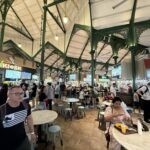

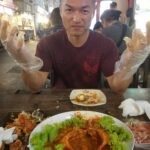

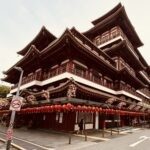


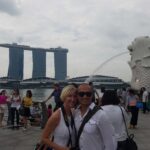
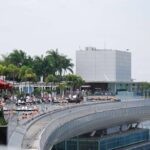
0 Comments